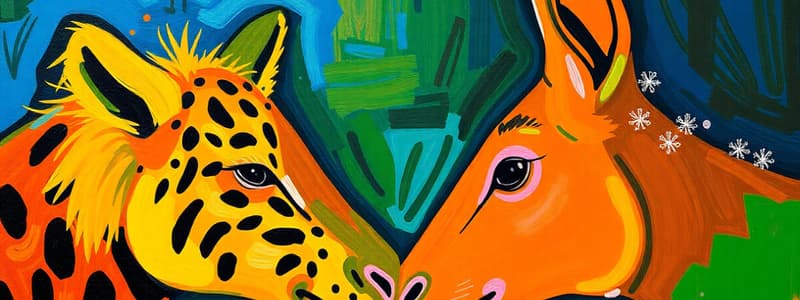Podcast
Questions and Answers
What does social behavior primarily involve?
What does social behavior primarily involve?
- Interactions among individuals within a group (correct)
- Individual survival mechanisms
- Diverse ways animals hide from predators
- Repeated actions occurring in a predictable manner
Which of the following is an example of cooperation in social behavior?
Which of the following is an example of cooperation in social behavior?
- Honeybees working together for hive maintenance (correct)
- Male birds competing for mates
- Lions engaging in solitary hunting
- Rabbits fighting over territory
What type of behavior occurs when animals use vocalizations or signals to convey information?
What type of behavior occurs when animals use vocalizations or signals to convey information?
- Competition
- Solitary behavior
- Communication (correct)
- Aggression
Which behavior is characterized by fights over resources or dominance?
Which behavior is characterized by fights over resources or dominance?
What is a characteristic of solitary social structures in animals?
What is a characteristic of solitary social structures in animals?
What is cyclic behavior in animals?
What is cyclic behavior in animals?
Which behavior would not typically be considered social behavior?
Which behavior would not typically be considered social behavior?
How can understanding population dynamics benefit conservation efforts?
How can understanding population dynamics benefit conservation efforts?
What role does knowledge of cyclic behaviors play in species protection?
What role does knowledge of cyclic behaviors play in species protection?
What is the significance of social behaviors in habitat management?
What is the significance of social behaviors in habitat management?
How does understanding behavior enhance animal welfare in captive environments?
How does understanding behavior enhance animal welfare in captive environments?
Which of the following best describes cyclic behavior?
Which of the following best describes cyclic behavior?
What is a key benefit of living in groups for animals?
What is a key benefit of living in groups for animals?
Which type of cyclic behavior is most closely associated with daily activities?
Which type of cyclic behavior is most closely associated with daily activities?
What factor can trigger cyclic behaviors in animals?
What factor can trigger cyclic behaviors in animals?
In which way can social behavior influence reproductive cycles?
In which way can social behavior influence reproductive cycles?
What is an example of a cyclic behavior driven by external cues?
What is an example of a cyclic behavior driven by external cues?
Which is an evolutionary advantage of cyclic behavior?
Which is an evolutionary advantage of cyclic behavior?
How do social interactions influence cyclic behaviors in migratory birds?
How do social interactions influence cyclic behaviors in migratory birds?
What role do hormones play in cyclic behaviors?
What role do hormones play in cyclic behaviors?
What type of social structure can be found in primate troops?
What type of social structure can be found in primate troops?
What aspect of social behavior can enhance cyclic behaviors in social insects?
What aspect of social behavior can enhance cyclic behaviors in social insects?
Flashcards are hidden until you start studying
Study Notes
Introduction to Animal Behavior
- Animal behavior is the way animals interact with their environment, each other, and their own species.
- Social behavior involves interactions among individuals within a group.
- Cyclic behavior refers to repetitive patterns of behavior that occur in a regular, predictable manner.
Social Behavior
- Social behavior is essential for understanding how animals live and function within their social structures.
- Cooperation involves individuals working together for mutual benefit, e.g. honeybee colonies.
- Communication is crucial for conveying information among individuals, e.g. wolves howling.
- Competition occurs when individuals vie for limited resources, e.g. bird courtship displays.
- Aggression involves confrontations between individuals, often related to resources or dominance, e.g. male deer antler fights.
Types of Social Structures
- Solitary: Animals have little to no social structure beyond individual interactions, e.g. tigers.
- Pair Bonds: A male and female work together to raise offspring and defend their territory, e.g. swans.
- Groups: These groups can be organized in various ways, e.g. herds of elephants or packs of wolves.
Evolutionary Significance of Social Behavior
- Enhanced Survival: Living in groups can increase survival through collective defense against predators, e.g., schools of fish.
- Improved Resource Acquisition: Cooperation among group members can enhance resource acquisition, e.g. ants working together.
- Reproductive Success: Social structures can influence reproductive success, e.g. dominant individuals have greater access to mates.
Cyclic Behavior
- Cyclic behaviors are often driven by internal biological rhythms or external environmental cues and can be crucial for survival and reproduction.
Types of Cyclic Behavior
- Circadian Rhythms: daily cycles that influence behavior and physiology, e.g. sleep-wake cycles.
- Seasonal Rhythms: changes in behavior or physiology in response to seasonal variations, e.g. migratory birds.
- Reproductive Cycles: patterns related to mating and reproduction, e.g. female mammals often have estrous cycles.
- Lunar Cycles: behaviors influenced by lunar cycles, e.g. coral spawning.
Mechanisms Behind Cyclic Behavior
- Internal Biological Clocks: regulate daily rhythms and are driven by the suprachiasmatic nucleus (SCN) in the brain.
- Environmental Cues: external environmental cues, such as changes in light, temperature, or food availability, can trigger behaviors.
- Hormonal Regulation: hormones play a key role in regulating cyclic behaviors, such as reproductive cycles.
Evolutionary Significance of Cyclic Behavior
- Optimized Resource Use: Cyclic behavior helps animals optimize resource use by aligning their activities with environmental conditions, e.g. hibernating animals.
- Enhanced Reproductive Success: Reproductive cycles ensure that mating and birthing occur during favorable conditions, increasing the likelihood of offspring survival.
- Survival Advantages: Cyclic behaviors, such as migration, allow animals to exploit different habitats seasonally, maximizing survival and access to resources.
Comparing Social Behavior and Cyclic Behavior
- Social behavior can enhance cyclic behaviors by facilitating synchronization within a group.
- Cyclic behaviors can affect group dynamics.
- Social and cyclic behaviors can interact and influence each other in various ways.
Practical Applications
- Understanding social and cyclic behaviors has practical implications for ecology, conservation, and animal welfare.
Ecological Insights
- Population Dynamics: Studying migration patterns can provide information on how environmental changes impact species distributions and interactions.
- Ecosystem Functions: Knowledge of pollinator behaviors can help in designing effective conservation strategies for endangered plants.
Conservation Efforts
- Species Protection: Protecting breeding grounds during specific times of the year can enhance conservation efforts for migratory species.
- Habitat Management: Creating protected areas that support social structures and group dynamics can improve the success of conservation programs.
Animal Welfare
- Captive Environments: Ensuring that captive animals' social needs and cyclic behaviors are met can improve their welfare and reduce stress.
- Behavioral Enrichment: Providing environmental enrichment that stimulates natural behaviors can enhance the well-being of captive animals and promote their overall health.
Conclusion
- Social and cyclic behaviors are fundamental aspects of animal behavior.
- Understanding these behaviors provides valuable insights into the survival, reproduction, and adaptation of animals in their respective environments.
- By studying social and cyclic behaviors, researchers and conservationists can improve our knowledge of animal ecology, enhance conservation efforts, and promote the welfare of captive animals.
Studying That Suits You
Use AI to generate personalized quizzes and flashcards to suit your learning preferences.




